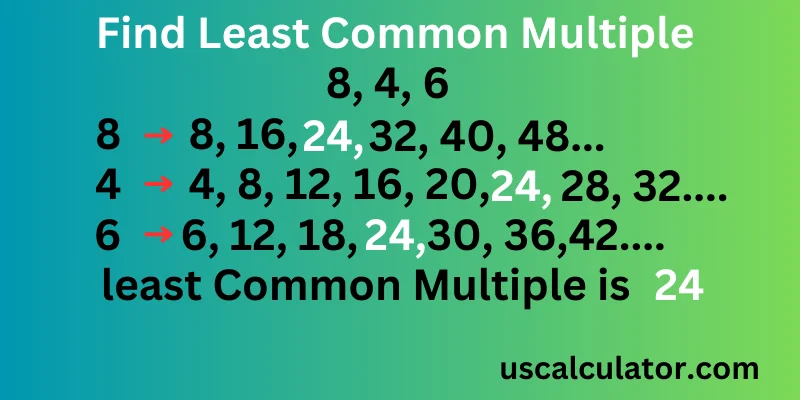Least Common Multiple Calculator (LCM)
Need to add fractions or solve ratio problems? Our Least Common Multiple (LCM) Calculator finds the smallest common multiple instantly! Just enter your numbers, and get results in seconds.
Share Calculator
Common Calculators | |
Table of Contents

What is a Least Common Multiple (LCM)?
The smallest positive integer that is divisible by two or more given numbers.
Example: LCM of 4 and 6 is 12. how to? I would like you to know how to learn it.
The smallest positive number that's separable by each of the given numbers with leaving a remainder, is the least common multiple (LCM) of two or more integers. And that is the least common of the numbers, in other words.
Here we take numbers 4 and 6, for example.
The products of 4 are 4, 8, 12, 16, 20, 24, 28,...
And the products of 6 are 6, 12, 18, 24, 30, 36,...
The slightest common difference is the smallest number in both records, which is 12. Subsequently, the LCM of 4 and 6 is 12.
We have given the calculation equation for the last common multiple calculation in two pictures.
Here are two examples of least common multiple calculations, each using a different method:
1. Prime Factorization Method
Formula:
LCM = Product of the highest powers of all primes in the factorization
Steps:
Factorize each number into primes.
Take all unique primes with their highest exponents.
Multiply them.
Example: Find LCM 12 and 18
12 = 22 × 31
18 = 21 × 32
Highest powers: 22 × 32
LCM = 4 × 9 = 36
2. Division Method
Steps:
Divide all numbers by common primes.
Repeat until no common prime exists.
Multiply all divisors and remainders.
Example: Find LCM 24, 30, and 45.
| 2 | | 24, | 30, | 45 |
| 3 | | 12, | 15, | 45 |
| 5 | | 4, | 5, | 15 |
| | | 4, | 1, | 3 |
Divisors: 2 × 3 × 52 × 3 × 5
Remainders: 4 × 1 × 34 × 1 × 3
LCM = 2 × 3 × 5 × 4 × 3 = 360
3. GCD Formula (For 2 Numbers Only)
Formula
| LCM (a,b) = |
|
Example: Find LCM(15, 20)
GCD(15, 20) = 5
15 × 20 = 300
LCM = 300/5 = 60
Example 4.
Here, we take an example in which we will use the brute force method.
For example, we will find the least common multiple (LCM) of 8 and 12.
First, we will write a list of multiples of 8: 8, 16, 24, 32, 40, 48,
Now we will write a list of multiples of 12: 12, 24, 36, 48, 60,
Now, we will identify the first number that appears in both lists. 24.
So, the LCM of 8 and 12 is 24.
Example 5.
Here, we take an example in which we will use the prime factorization method.
Here, we will find the LCM of 15 and 20, for example.
Here, we will factor each number into prime factors. 15 = 3 × 5
20 = 2 × 2 × 5
Now, we will identify the highest power of each prime factor present in any number.
3. occurs once in both numbers (the highest power is 1).
5. occurs once in both numbers (the highest power is 1).
2. occurs twice in 20 (the highest power is 1; the lowest power is 2). Now, we will multiply the prime factors by their highest powers. LCM = 3^1 × 5^1 × 2^2 = 60. So, the LCM of 15 and 20 is 60.
Summary Table
| Method | Best For | Example |
|---|---|---|
| Prime Factorization | Any number of values | LCM(12,18) = 36 |
| Division | 3 + values | LCM(24,30,45) = 360 |
| GCD Formula | Exactly 2 values | LCM(15,20) = 60 |
Applications
Synchronizing Events:
Traffic lights changing every 2 mins (A) and 3 mins (B).
LCM (2,3) = 6 → Lights sync every 6 mins.
Fraction Operations:
| Adding |
|
+ |
|
: LCM (4,6) = 12 |
|
+ |
|
= |
|
Manufacturing:
Gear rotations: Gear A (8 teeth), Gear B (12 teeth).
LCM (8,12) = 24 → Gears realign every 24 teeth rotations.